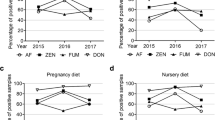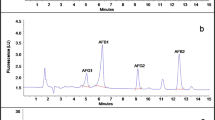Abstract
A study was conducted to evaluate the occurrence of ochratoxin A (OTA) in complete poultry feeds (n = 80) and poultry feed ingredients (n = 286) from Pakistan. All samples were first analyzed by indirect enzyme linked immunosorbent assay (ELISA), samples with OTA concentrations above the European Union maximum regulatory limit (MRL, 100 μg/kg) were further confirmed by HPLC-FLD. Contamination frequency and mean OTA levels were 31 % and 51 μg/kg in feed ingredients, and the corresponding values for complete feeds were 38 % and 75 μg/kg. Ten samples of complete poultry feed and 19 samples of feed ingredients contained OTA at levels higher than the MRL. The results of the present study indicate that there is a strong need for a more intense monitoring programs for OTA in poultry feed.



Similar content being viewed by others
References
Akhtar MS, Nasir Z, Abid AR (2003) Effect of feeding powdered Nigella sativa L. seeds on poultry egg production and their suitability for human consumption. Vet arhiv 73:181–190
Alam S, Shah HU, Khan H, Magan N (2012) The effect of substrate. Season, and agroecological zone on mycoflora and aflatoxin contamination of poultry feed from Khyber Pakhtunkhwa, Pakistan. Mycopathol 174:341–349
Castillo M-Á, Montes R, Navarro A, Segarra R, Cuesta G, Hernández E (2008) Occurrence of deoxynivalenol and nivalenol in Spanish corn-based food products. J Food Compos Anal 21:423–427
EC (2002) European Commission. Commission directive no. 2002/27/EC of 13 March 2002 amending Directive 98/53/EC laying down the sampling methods and the method of analysis for the official control of the levels for certain contaminants in foodstuffs. Off J Eur Communities L75:44–45
EC (2006) European Commission. Commission recommendation (2006/576/EC) of 17 August 2006 on the presence of deoxynivalenol, zearalenone, ochratoxin a, T-2 and HT-2 and fumonisins in products intended for animal feeding. Off J Eur Union 229:7–9
Farhat Zafar NY, Hassan R, Naim T, Qureshi A (2001) A study on the analysis of ochratoxin-A in different poultry feed ingredients. Pak J Pharm Sci 14:5–7
Firdous S, Ejaz N, Aman T, Khan N (2012) Occurrence of aflatoxins in export-quality Pakistani rice. Food Addit Contam Part B 5:121–125
Hussein HS, Brasel JM (2001) Toxicity, metabolism, and impact of mycotoxins on humans and animals. Toxicology 167:101–134
Ilyas F (2007) Toxin behind livestock deaths identified. The Dawn, Islamabad, Pakistan
Iqbal SZ, Rabbani T, Asi MR, Jinap S (2014) Assessment of aflatoxins, ochratoxin A and zearalenone in breakfast cereals. Food Chem 157:257–262
Leeson S, Summers JD (2009) Commercial poultry nutrition. University Press, Nottingham
Lindblad M, Johnsson P, Jonsson N, Lindqvist R, Olsen M (2004) Predicting noncompliant levels of ochratoxin A in cereal grain from Penicillium verrucosum counts. J Appl Microbiol 97:609–616
Majeed S, Iqbal M, Asi MR, Iqbal SZ (2013) Aflatoxins and ochratoxin A contamination in rice, corn and corn products from Punjab. Pak J Cereal Sci 58:446–450
Nesheim S, Stack M, Trucksess M, Eppley R, Krogh P (1992) Rapid solvent-efficient method for liquid chromatographic determination of ochratoxin A in corn, barley, and kidney: collaborative study. J AOAC Int 75:481–487
Niaz I, Dawar S, Najum-us-Sahar (2012) Detection of mycotoxins in maize seed samples. Pak J Bot 44:1075–1078
Park JW, Choi S-Y, Hwang H-J, Kim Y-B (2005) Fungal mycoflora and mycotoxins in Korean polished rice destined for humans. Int J Food Microbiol 103:305–314
Paterson R, Lima N (2011) Further mycotoxin effects from climate change. Food Res Int 44:2555–2566
Pittet A (1998) Natural occurrence of mycotoxins in foods and feeds: an update review. Rev Med Vet 149:479–492
Prior M, Sisodia C (1978) Ochratoxicosis in white leghorn hens. Poultry Sci 57:619–623
Rashid N et al (2012) Prevalence of aflatoxin B1 in finished commercial broiler feed from west central. Pak J Anim Plant Sci 22:6–10
Ratnavathi CV, Komala VV, Kumar BSV, Das IK, Patil JV (2012) Natural occurrence of aflatoxin B1 in sorghum grown in different geographical regions of India. J Sci Food Agric 92:2416–2420
Ravindran V, Blair R (1992) Feed resources for poultry production in Asia and the pacific. II. Plant protein sources. World’s Poult Sci J 48:205–231
Shah HU, Simpson TJ, Alam S, Khattak KF, Perveen S (2010) Mould incidence and mycotoxin contamination in maize kernels from Swat valley northwest frontier province of Pakistan. Food Chem Toxicol 48:1111–1116
Shar Z, Sumbal G, Sherazi S, Bhanger M, Nizamani S (2013) Natural co-occurrence of aflatoxins and deoxynivalenol in poultry feed in Pakistan food additives & contaminants: part B
Sherazi STH, Shar ZH, Bhanger MI, Sumbal GA, Nizamani SM (2013) Economical appraisal of total aflatoxin level in the poultry feeds by fourier transform infrared spectroscopy. J Pak Chem Soc 35:363–368
Soleas GJ, Yan J, Goldberg DM (2001) Assay of ochratoxin A in wine and beer by high-pressure liquid chromatography photodiode array and gas chromatography mass selective detection. J Agric Food Chem 49:2733–2740
Sultana N, Hanif N (2009) Mycotoxin contamination in cattle feed and feed ingredients. Pak Vet J 29:211–213
Sulyok M, Krska R, Schuhmacher R (2007) A liquid chromatography/tandem mass spectrometric multi-mycotoxin method for the quantification of 87 analytes and its application to semi-quantitative screening of moldy food samples. Anal Bioanal Chem 389:1505–1523
Turner NW, Subrahmanyam S, Piletsky SA (2009) Analytical methods for determination of mycotoxins: a review. Anal Chim Acta 632:168–180
Van Egmond HP, Schothorst RC, Jonker MA (2007) Regulations relating to mycotoxins in food. Anal Bioanal Chem 389:147–157
Visconti A, Bottalico A (1983) High levels of ochratoxins A and B in moldy bread responsible for mycotoxicosis in farm animals. J Agric Food Chem 31:1122–1123
Wild CP, Gong YY (2010) Mycotoxins and human disease: a largely ignored global health issue. Carcinog 31:71–82
Acknowledgments
The authors would like to thank TUBITAK for providing the financial support to Professor Dr. S. T. H. Sherazi under TUBITAK 2221 Fellowship for Visiting Scientists and Scientists on Sabbatical Leave program.
Source of funding
The authors would like to acknowledge with great thanks the Higher Education Commission (HEC), Pakistan, for providing the financial support to carry out this research work under project no. 20-1544/R&D/09/2204.
Conflict of interest
The authors would like to declare that there is no any actual or potential conflict of interest including any financial, personal, or other relationships with other people or organizations or funding source within 3 years of beginning the submitted work that could inappropriately influence, or be perceived to influence, their work.
Author information
Authors and Affiliations
Corresponding author
Rights and permissions
About this article
Cite this article
Sherazi, S.T.H., Shar, Z.H., Sumbal, G.A. et al. Occurrence of ochratoxin A in poultry feeds and feed ingredients from Pakistan. Mycotoxin Res 31, 1–7 (2015). https://doi.org/10.1007/s12550-014-0216-0
Received:
Revised:
Accepted:
Published:
Issue Date:
DOI: https://doi.org/10.1007/s12550-014-0216-0




